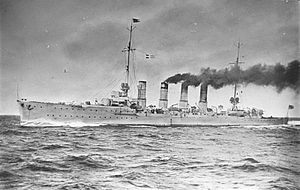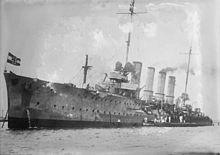
SMS Lützow was the second Derfflinger-class battlecruiser built by the German Kaiserliche Marine before World War I. Ordered as a replacement for the old protected cruiser Kaiserin Augusta, Lützow was launched on 29 November 1913, but not completed until 1916. Lützow was a sister ship to Derfflinger from which she differed slightly in that she was armed with an additional pair of 15 cm (5.9 inch) secondary guns and had an additional watertight compartment in her hull. She was named in honor of the Prussian general Ludwig Adolf Wilhelm von Lützow who fought in the Napoleonic Wars.

SMS Seydlitz was a battlecruiser of the German Kaiserliche Marine, built in Hamburg. She was ordered in 1910 and commissioned in May 1913, the fourth battlecruiser built for the High Seas Fleet. She was named after Friedrich Wilhelm von Seydlitz, a Prussian general during the reign of King Frederick the Great and the Seven Years' War. Seydlitz represented the culmination of the first generation of German battlecruisers, which had started with the Von der Tann in 1906 and continued with the pair of Moltke-class battlecruisers ordered in 1907 and 1908. Seydlitz featured several incremental improvements over the preceding designs, including a redesigned propulsion system and an improved armor layout. The ship was also significantly larger than her predecessors—at 24,988 metric tons, she was approximately 3,000 metric tons heavier than the Moltke-class ships.
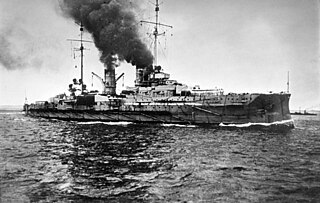
SMS Blücher was the last armored cruiser built by the German Empire. She was designed to match what German intelligence incorrectly believed to be the specifications of the British Invincible-class battlecruisers. Blücher was larger than preceding armored cruisers and carried more heavy guns, but was unable to match the size and armament of the battlecruisers which replaced armored cruisers in the British Royal Navy and German Imperial Navy. The ship was named after the Prussian Field Marshal Gebhard von Blücher, the commander of Prussian forces at the Battle of Waterloo in 1815.

SMS Elbing was a light cruiser ordered by the Imperial Russian navy under the name Admiral Nevelskoy from the Schichau-Werke shipyard in Danzig in 1913. Following the outbreak of World War I, the ship was confiscated in August 1914 and launched on 21 November 1914 as SMS Elbing. She had one sister ship, Pillau, the lead ship of their class. The ship was commissioned into the High Seas Fleet in September 1915. She was armed with a main battery of eight 15 cm SK L/45 guns and had a top speed of 27.5 kn.

SMS Frankfurt was a light cruiser of the Wiesbaden class built by the German Kaiserliche Marine. She had one sister ship, SMS Wiesbaden; the ships were very similar to the previous Karlsruhe-class cruisers. The ship was laid down in 1913, launched in March 1915, and completed by August 1915. Armed with eight 15 cm SK L/45 guns, Frankfurt had a top speed of 27.5 knots and displaced 6,601 t at full load.

SMS Wiesbaden was a light cruiser of the Wiesbaden class built for the Imperial German Navy. She had one sister ship, SMS Frankfurt; the ships were very similar to the previous Karlsruhe-class cruisers. The ship was laid down in 1913, launched in January 1915, and completed by August 1915. Armed with eight 15 cm SK L/45 guns, Wiesbaden had a top speed of 27.5 knots and displaced 6,601 t at full load.
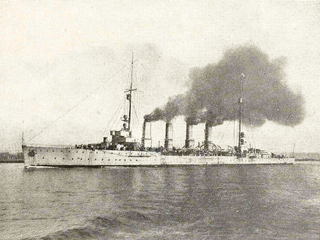
SMS Stralsund was a Magdeburg-class light cruiser of the German Kaiserliche Marine. Her class included three other ships: Magdeburg, Breslau, and Strassburg. She was built at the AG Weser shipyard in Bremen from 1910 to December 1912, when she was commissioned into the High Seas Fleet. The ship was armed with a main battery of twelve 10.5 cm SK L/45 guns and had a top speed of 27.5 knots.

SMS Stettin was a Königsberg-class light cruiser of the Kaiserliche Marine. She had three sister ships: Königsberg, Nürnberg, and Stuttgart. Laid down at AG Vulcan Stettin shipyard in 1906, Stettin was launched in March 1907 and commissioned into the High Seas Fleet seven months later in October. Like her sisters, Stettin was armed with a main battery of ten 10.5 cm (4.1 in) guns and a pair of 45 cm (18 in) torpedo tubes, and was capable of a top speed in excess of 25 knots.

The Derfflinger class was a class of three battlecruisers of the Imperial German Navy. The ships were ordered for the 1912–13 Naval Building Program of the German Imperial Navy as a reply to the Royal Navy's two new Lion-class battlecruisers that had been launched a few years earlier. The preceding Moltke class and the incrementally improved Seydlitz represented the end of the evolution of Germany's first generation of battlecruisers. The Derfflinger class had considerable improvements, including a larger primary armament, all of which was mounted on the centerline. The ships were also larger than the preceding classes. The Derfflinger class used a similar propulsion system, and as a result of the increased displacement were slightly slower.

The Cöln class of light cruisers was Germany's last class commissioned before her defeat in World War I. Originally planned to comprise ten ships, only two were completed; Cöln and Dresden. Five more were launched, but not completed: Wiesbaden, Magdeburg, Leipzig, Rostock and Frauenlob, while another three were laid down but not launched: Ersatz Cöln, Ersatz Emden and Ersatz Karlsruhe. The design was a slightly modified version of the preceding Königsberg class.

The Wiesbaden class of light cruisers was a class of ships built by the German Kaiserliche Marine shortly before the outbreak of World War I. Two ships were built in this class, Wiesbaden and Frankfurt. They were very similar to the preceding design, the Graudenz class, though they were armed with eight 15 cm SK L/45 guns instead of the twelve 10.5 cm SK L/45 guns on the earlier vessels. The ships had a top speed of 27.5 knots.
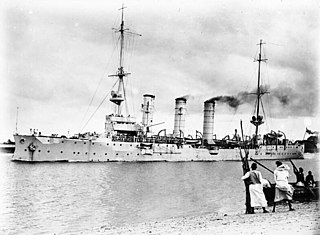
The Königsberg class was a group of four light cruisers built for the German Imperial Navy. The class comprised four vessels: SMS Königsberg, the lead ship, SMS Nürnberg, SMS Stuttgart, and SMS Stettin. The ships were an improvement on the preceding Bremen class, being slightly larger and faster, and mounting the same armament of ten 10.5 cm SK L/40 guns and two 45 cm (17.7 in) torpedo tubes.

The Königsberg class of light cruisers was a group of four ships commissioned into Germany's Kaiserliche Marine shortly before the end of World War I. The class comprised Königsberg, Karlsruhe, Emden, and Nürnberg, all of which were named after light cruisers lost earlier in the war. The ships were an incremental improvement over the preceding Wiesbaden-class cruisers, and were armed with a main battery of eight 15 cm (5.9 in) SK L/45 guns and had a designed speed of 27.5 knots.

SMS Rostock was a light cruiser of the Karlsruhe class built by the German Kaiserliche Marine. She had one sister ship, SMS Karlsruhe; the ships were very similar to the previous Magdeburg-class cruisers. The ship was laid down in 1911, launched in November 1912, and completed by February 1914. Armed with twelve 10.5 cm SK L/45 guns, Rostock had a top speed of 28.5 knots and displaced 6,191 t at full load.

The Magdeburg class of light cruisers was a group of four ships built for the Imperial German Navy. The class comprised SMS Magdeburg, the lead ship, Breslau, Strassburg, and Stralsund. All four ships were laid down in 1910 and were completed by the end of 1912. They were armed with a main battery of twelve 10.5 cm guns, though over the course of their careers, Breslau, Strassburg, and Stralsund were rearmed with more powerful 15 cm guns. They displaced 4,570 t at full load and were rated at a top speed of 27.5 knots, though all four vessels exceeded that figure on trials.

The Pillau class of light cruisers was a pair of ships built in Germany just before the start of World War I. The class consisted of SMS Pillau and Elbing. The ships were initially ordered for the Imperial Russian Navy in 1912, and were built by the Schichau-Werke shipyard in Danzig. After the outbreak of World War I, however, the German Kaiserliche Marine confiscated the ships before they were completed. The ships were similar in design to other German light cruisers, although they lacked an armored belt. They were the first German light cruisers to be equipped with 15 cm SK L/45 guns, of which they carried eight. The two ships had a top speed of 27.5 knots.

The Graudenz class of light cruisers was a class of two ships built for the Imperial German Navy. The class comprised SMS Graudenz and SMS Regensburg. The ships both were laid down in 1912, launched in October 1913 and April 1914 and commissioned in August 1914 and January 1915, respectively. They were armed with a main battery of twelve 10.5 cm (4.1 in) guns, though over the course of their careers, they were rearmed with seven more powerful 15 cm (5.9 in) guns. They displaced 6,382 t at full load and were rated at a top speed of 27.5 knots

SMS Graudenz was the lead ship of her class of light cruisers. She had one sister ship, SMS Regensburg. The ship was built by the German Kaiserliche Marine in the Kaiserliche Werft shipyard in Kiel, laid down in 1912 and commissioned into the High Seas Fleet in August 1914, days after the outbreak of World War I. She was named for the then-German town of Graudenz. The ship was armed with a main battery of twelve 10.5 cm SK L/45 guns and had a top speed of 27.5 knots.
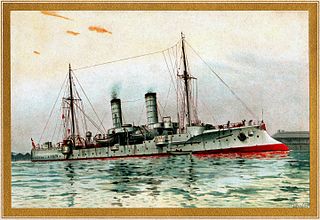
The Gazelle class was a group of ten light cruisers built for the Imperial German Navy at the turn of the 20th century. They were the first modern light cruiser design of the Imperial Navy, and set the basic pattern for all future light cruisers in Imperial service. The design of the Gazelle class attempted to merge the fleet scout with the colonial cruiser. They were armed with a main battery of ten 10.5 cm (4.1 in) guns and a pair of torpedo tubes, and were capable of a speed of 21.5 knots.
